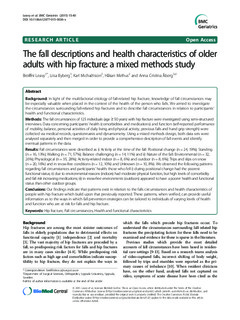| dc.contributor.author | Leavy, Breiffni | |
| dc.contributor.author | Byberg, Liisa | |
| dc.contributor.author | Michaëlsson, Karl | |
| dc.contributor.author | Melhus, Håkan | |
| dc.contributor.author | Åberg, Anna Cristina | |
| dc.date.accessioned | 2017-06-07T12:40:03Z | |
| dc.date.available | 2017-06-07T12:40:03Z | |
| dc.date.issued | 2015 | |
| dc.identifier.citation | Leavy, B., Byberg, L., Michaëlsson, K., Melhus, H. & Åberg, A.C. (2015) The fall descriptions and health characteristics of older adults with hip fracture: a mixed methods study. BMC Geriatrics, 2015, Vol.15(1). | |
| dc.identifier.issn | 1471-2318 | |
| dc.identifier.uri | http://hdl.handle.net/11250/2445126 | |
| dc.description | Artikkelen omhandler en studie hvor hensikten var å undersøke omstendighetene rundt fallrelaterte hoftebrudd samt beskrive omstendighetene rundt fall relatert til deltagernes helse og funksjonelle kjennetegn. | |
| dc.description.abstract | BACKGROUND: in light of the multifactorial etiology of fall-related hip fracture, knowledge of fall circumstances may be especially valuable when placed in the context of the health of the person who falls. We aimed to investigate the circumstances surrounding fall-related hip fractures and to describe fall circumstances in relation to participants' health and functional characteristics. METHODS: the fall circumstances of 125 individuals (age???50 years) with hip fracture were investigated using semi-structured interviews. Data concerning participants' health (comorbidities and medications) and function (self-reported performance of mobility, balance, personal activities of daily living and physical activity, previous falls and hand grip strength) were collected via medical records, questionnaires and dynamometry. Using a mixed methods design, both data sets were analysed separately and then merged in order to provide a comprehensive description of fall events and identify eventual patterns in the data. RESULTS: fall circumstances were described as i) Activity at the time of the fall: positional change (n?=?24, 19%); standing (n?=?16, 13%); walking (n?=?71, 57%); balance challenging (n?=?14, 11%) and ii) Nature of the fall: environmental (n?=?32, 26%); physiological (n?=?35, 28%); activity-related indoor (n?=?8, 6%) and outdoor (n?=?8, 6%); trips and slips on snow (n?=?20, 16%) and in snow-free conditions (n?=?12, 10%) and unknown (n?=?10, 8%). We observed the following patterns regarding fall circumstances and participants' health: those who fell i) during positional change had the poorest functional status; ii) due to environmental reasons (indoors) had moderate physical function, but high levels of comorbidity and fall risk increasing medications; iii) in snow-free environments (outdoors) appeared to have a poorer health and functional status than other outdoor groups. CONCLUSIONS: our findings indicate that patterns exist in relation to the falls circumstances and health characteristics of people with hip fracture which build upon that previously reported. These patterns, when verified, can provide useful information as to the ways in which fall prevention strategies can be tailored to individuals of varying levels of health and function who are at risk for falls and hip fracture. | |
| dc.language.iso | eng | |
| dc.rights | Navngivelse 4.0 Internasjonal | |
| dc.rights.uri | http://creativecommons.org/licenses/by/4.0/deed.no | |
| dc.subject | Sverige | |
| dc.title | The fall descriptions and health characteristics of older adults with hip fracture: a mixed methods study | |
| dc.type | Journal article | |
| dc.type | Peer reviewed | |
| dc.rights.holder | Leavy et al. | |
| dc.identifier.doi | 10.1186/s12877-015-0036-x | |

